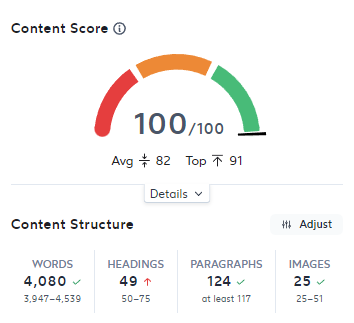
THIS is one huge reason we’re appearing first for your search query. Find out more below…


In 2022, more than 80% of people search for a business online before they visit the business or purchase a product. Websites have become an integral part of digital marketing and they can help businesses build brand trust and credibility to increase their conversion rates.
Consumer trust is important for any business, and in 2022, most consumers reported that they do not trust a company unless it has a website. It is so important that more than 64% of small businesses have launched a website.
This applies to any industry, especially eCommerce. Consequently, business owners need a roadmap to building a website.

The new website launch checklist can help you maneuver your way around your website launch so that you avoid making common mistakes and you can launch your website as quickly as possible.
Find our website checklist below, along with some website-building tools that can make the whole process easier!
There are many things to do before you are ready to launch your website.

The first thing to do before you start building your website is research. Research your industry trends and your competitors’ websites. This will give you a rough idea of what your website should look like, the information it should present, and the website design.
It is a good idea to follow web design trends to keep your website fresh and interesting, attracting more visitors who will spend more time looking at your business.

Building a website is a lot easier if you use the right tools. There are many web-building tools that you can use, and each has its benefits. However, you must find what works best for you. If you are unfamiliar with website building, you can use a tool for beginners, but there are also tools available for professional designers.
Wix is the most popular free website builder tool for new businesses, offering numerous features. Other website-building tools you can use include:
· GoDaddy
· Weebly
· WordPress
· Squarespace
· Jimdo
· Shopify
It is best to do your research and choose the one that will make your web-building easy and that can design a website according to your industry trends.
These tools can also help you pick a domain name, which will be your website’s identification.

Designing and building a website is only part of the launch process. Another part of the process is finding a host for your website. A web hosting service will give you a space to store your web content and allow visitors worldwide access to your business site.
There are different types of web hosting that you can choose, including:
· Shared
· Virtual Private Server (VPS)
· WordPress
· Cloud
· Dedicated
Many tools can help you incorporate your website on a host server, and you’ll need to assess which one works best for you.

Web design is a crucial step in building a website. Web design trends keep changing and you’ll want yours to be unique to capture visitor attention. The first thing to do is to choose a layout. There are many types of web layouts, the most popular ones include:
· Zig-Zag layout
· F-layout
· Split Screen layout
· Full-Screen layout
· Grid layout
· Featured Image layout
Once you have decided on the type of website layout, you must design your site to ensure that it generates the most traffic and keeps visitors engaged. This includes having high-quality images and videos, incorporating a color scheme that makes your site vibrant (but does not affect brand representation), and choosing a font.
Additionally, one of the essential elements of designing a website is your business logo. Your logo will give your business an identity and help potential customers recognize you. The business logo is typically displayed at the top of the homepage and smaller in the right corner of the other pages.

Before you are ready to launch your website make sure that all of the pages are complete and in their proper place. Incomplete pages make the reader think you’ve abandoned your business, and you will lose them.
Therefore, you’ll need to decide which pages to include on your website and where they should go. The homepage is very important, as it is the first page visitors will see. Appropriate calls to action (CTAs) and a navigation guide are also important.
Your website must also have a “Products” or “Services” page. These pages display any product or service you provide, giving visitors details and pricing. These are the second most visited pages on a website.
Finally, you need to add an “About Us” page and a “Contact” page. “About Us” gives background information about you and your business and lets your potential clients better understand your goals and values.
Depending on your business, you can also add other pages to your website, such as a blog page, an FAQ page, a news page, and any other information that will be important to your visitor.
After you have set your website pages, you must set your permalinks. Permalinks help to structure your website URL and help users navigate your website pages. This is important for your blogs and other website content and contains a domain name and a slug. The structure of your permalink will be something like this:
Yourwebsite.com/post-title

Most of your target audience will perform searches of your website on their mobile devices. Mobile devices have a smaller screen, and most websites (more than 94%) build their site to be mobile-friendly.
A variety of tools can check mobile device compatibilities, such as the LambdaTest tool or Google’s Mobile-friendly Test, which can test your website design on different screens.
Adding bullet points, images, and lower long-form texts can ensure that your website design is compatible with the smaller screen. Do not use text that is too large to fit on the screen or too small to be visible. Additionally, ensure those action elements are not difficult to press on mobile screens.

Many websites work perfectly on one browser but not on another, which can be a problem because different customers will use different browsers when they are online.
You’ll want to be sure that your website is compatible with different browsers. While there are many browsers. The top five are:
· Google Chrome
· Safari
· Edge
· Firefox
· Opera
You can check compatibility manually by visiting your website using each browser. Another more efficient way of checking is by using online tools that test your site, such as BrowserShots.

Even if a website is built and designed perfectly, it won’t matter if no one sees it. So, while it is essential to design your site to retain visitors, it is equally important to attract them in the first place. Search Engine Optimization (SEO) plays a major role in attracting potential customers to your website.
Search engines like Google target selective keywords and generate hits. These keywords are the words customers commonly use to find a product or service. The greater the hits, the better your rank on search engine rank pages (SERPs). An excellent rank is essential for any business site, as 75% of people do not scroll further than the first result page.
An SEO plugin like Yoast or SurferSEO can help you optimize your website to get a better ranking and attract more visitors. These services perform various functions. For example, they do keyword research, collect information on your niche, and help to prevent keyword stuffing.
You might be familiar with 404 pages. These pages show up when you try to visit a page that does not exist or if it’s not showing due to an error. These errors can occur when the user mistypes the URL or if there is a bug. That’s why it’s wise to prepare a 404 page to improve user experience and direct the user back to your homepage if there is a problem.
The 404 page should include clear instructions, a search bar, a redirect link to your home page, reasons why the error occurred, and contact information for your customer service. You can also set up email alerts for when an error occurs to stay on top of the problem. You can use online tools such as Elementor Pro to create and customize your 404 page.
A Secure Sockets layer (SSL) certificate validates your business site’s identity and is visible as an HTTPS (Hypertext Transfer Protocol Secure) in your website URL. An SSL certificate is crucial for all websites, especially eCommerce. Without a certificate, users’ browsers show your website as “not secure” and your visitors are likely to leave.
There are many online services that offer SSL certificates, such as Let’s Encrypt. Some certificates are free and others are available for purchase. Once you have your SSL certificate, you should route your website traffic through HTTPS to ensure security for your website and visitors. You can also refer to guidelines from Google on how to enable HTTPS.

Websites are vulnerable to malware, bugs, and cyber attacks. Although rare, these are the worst things that can happen to them. While there are ways to deal with such issues as they pop up, having a backup of your website can save you if disaster strikes.
You can back up your website manually by downloading files or by using an online service. Alternatively, your website host will offer a backup as a default feature.
Our ultimate website launch checklist for 2022 will help you prepare for the launch, but it is still easy to overlook the “little things.” After launching your website, you might notice mistakes and then need to make corrections. Of course, it is more efficient (and easier!) to get everything right before you launch your site. Here are some of the little things you will want to double-check:
Remove dummy (placeholder) content. Dummy content is set by your web builder tool and includes simple phrases like “Hello World!”
Deactivate unused plugins. You might have tried different plugins that you did not end up using. They will lower your website’s performance and should be deactivated.
Set the time zone. Your website time zone plays a critical role when your web builder performs tasks such as posting new content. You can set your time zone to your local time or your target audience’s zone.
Enable search engine visibility. It is best to disable this feature while in the building stage so potential clients can’t visit the unfinished site. Don’t forget to turn the feature back on once you are done!
Edit comment settings. Unless you prefer having comments on your website, it is best to disable them to prevent spam.
Edit site title and tagline. This information is automatically filled by default and must be changed before you are ready to launch.
Set up a privacy policy to keep yourself safe legally.
Proofread and double-check all content on the website. This includes checking for grammatical errors, redundancy, and SEO content.
Add title tags and meta descriptions to all content pages to get a better ranking on SERPs.
Add 301 redirects to your new site.

Launching a site is just part of the entire website process. You are not finished after you build and launch your site. There are many things to do post-launch.

Analytics tools help you assess your website’s performance. They will help you to better understand your visitors. Analytics tools collect information, such as your website traffic data, demographics, bounce rate, etc.
There are many analytics tools and solutions available. However, the best solution for your business is Google Analytics, a free and comprehensive analytics tool that can help you track and improve your website performance.

It is essential to review your website even after the launch because you might have missed some errors. Every web page should be reviewed to ensure proper layout, format, and image quality, and to ensure that your SEO content follows all search engine optimization criteria.
Although not required, Google’s Accelerated Mobile Pages (AMP) framework can help you improve your site performance. This framework focuses on customizing and setting guidelines for your website on smaller screens, such as mobile phones.
However, depending on your website content and layout, you’ll need to be careful when using AMP. While AMP is a great framework to integrate for blogs and articles, it can impact the user experience for other website content.
Calls to action’s (CTAs) help you move to the conversion stage of the marketing funnel where you can increase the conversion rate of potential customers.
Examples of CTAs include “Contact our Customer Service” and “Proceed to Checkout.” CTAs should be prominent and clear and entice your audience to take action.

When you launch a site, it’s a great idea to generate hype. One way to generate hype and attract more visitors is to promote your website on social media. The most popular social media platforms include Facebook, Instagram, Twitter, and LinkedIn.
Start creating a social media presence when you are close to your launch date and post “coming soon” content. Your social media page and post should also include a link to your website.

While social media is an excellent way of attracting visitors to your website, there are many other digital marketing tactics. Some of the best ways to promote your new business site through digital marketing include:
SEO content attracts organic traffic to your sites and improves click rates by incorporating relevant short-tail and long-tail keywords.
Paid ads are a significant short-term boost of traffic to your website. Google AdWords is one popular tool used to create advertisements.
E-marketing involves sending promotional emails to clients that are in your database whenever new updates, content, services, or products are introduced.

Designing and optimizing your website to attract visitors is crucial. Website optimization will improve your SERP rank and will drive more traffic to your site – the higher your rank is on search engines, the more visitors you will get. There are different ways that you can improve your rank on result pages.

Content marketing is an integral part of search engine result page ranking, and the way to get a higher rank is by posting SEO content on your website. SEO content marketing generates six times more visitors and customer conversions than other marketing. There are different ways to ensure that your content is SEO friendly. They include using:
· Target audience and keyword research
· Keyword optimization
· Meta Tags and Titles
Your content should be informative and not redundant, offering new pieces of information with every sentence.
You can use SEO tools such as SurferSEO to write content that ensures a higher ranking on search engines. Alternatively, you can outsource content writing to experienced professionals, such as Bellio Digital. These services have the required skill and tools to create unique, SEO-friendly content for your business’s website.
Popular search engines, like Google, will look at your link building to rank your website. Link building is the ability to get other websites to link to yours. The more links you have, then the better your rank, especially if you are linked with reputable sites.
Link building represents your business’s credibility and authority. It assures readers that you are an expert in your niche industry. Link building will only be successful if your content is informative and correct so that other businesses will use it as a reference.
You can also improve links by connecting with bloggers and publishers in your niche to use your content and build the press. Additionally, you’ll want to make sure that your website has no broken links.
Similarly, you can add internal links to your content – links that connect to another page of your website. This boosts brand authority as visitors jump to new content on your site, letting Google know that your website has relevant and credible information.

Improving your click-through rate (CTR) can also improve your ranking. CTR represents the percentage of users that click on your website on a search results page. For example, if a hundred people do a search and see your site and 40 clicks are generated, then your website CTR is 40%.
A greater CTR means that your content is more relevant to the searched keywords, and you will rank higher on SERPs. You can improve your click-through rate by including appropriate keywords in your title and meta descriptions.
One excellent way of increasing CTRs is to use Schema markup, the language of search engines. “How-To” or “Top Best” titles often increase CTRs, as well.
You might find that online tools are helpful, such as Google Search Console, which will monitor and score your CTR, with a good score being above 30%. The higher the better!

When it comes to content marketing, more people prefer to look at images and videos instead of reading long-form articles. If applicable, integrate infographics and multimedia into your content. Adding pictures, graphs, charts, or slides is a great way of boosting readability. Additionally, your multimedia should feature SEO-friendly tags and alt text.

Google searches for fresh relevant content and uses it as a factor for rankings. So, the older the content gets, the lower it falls and you are less likely to see a post from many years ago.
To keep up, you’ll need to upload and update content frequently and regularly. You don’t have to update daily – just put the updates on a regular, manageable schedule. For example, if you update new content three days a week and then neglect it for a whole month, your website rank can take a beating.
Google Analytics (GA) is an important and useful tool that can help website owners and builders assess their website performance and collect data on site visitors. More than 56% of websites use Google Analytics to assess their progress.
Below are a few ways that Google analytics can help you develop your website.
GA collects data on your website traffic, including where the visitors come from. It is vital for businesses to know their traffic sources in order to strategize on how to get the most from them. Different sources of traffic include:
· Organic Searches
· Social Media Traffic
· Backlink Traffic
· E-marketing Traffic
· Advertisements
· And More
GA lets you understand how your visitors or customers behave on your website. This includes information about bounce rates, time spent on each page, top pages, and more. For new websites, it is valuable to know which page on the site performs best and which performs the lowest.
When potential customers become paying customers, the conversion rate will increase – the main goal of most businesses. Conversion rate data is very useful and enables you to track your progress, assess marketing performance and update your website to meet your goals.
It’s important to know your audience! Google Analytics makes finding and researching your target audience easier. GA collects demographic data that can pinpoint your target audience’s gender, age, interests, and more. This information can be used to evaluate different ways to interest and engage them.

Setting up the Google Analytics solution is easy if you follow the step-by-step instructions below:
The first step to setting up GA is to create an Analytics account. You can create an account by selecting the Admin option on the GA app or software.
Follow the instructions and fill out the account name and the property (website name and URL). Be sure to choose the correct time zone and category. Finally, add the preferred currency. You can go to the Advanced Settings option to add Google Analytics 4 (GA4) to sites that already use universal analytics.
Next, add the GA tracking ID to your website to set up your GA service. To do so, select Tracking Info and choose Admin and Tracking Code. If you also have GA4, then select Universal Analytics. Copy and paste the code to the appropriate code section on your website which may be on one specific page or several depending on your goals!

With years of experience and trained writers that have the necessary skills and knowledge to create content for your website, Bellio Digital can help you rank higher on result pages and attract more organic traffic!
We were named The Best Ad Agency of 2022 by Fort Lauderdale Magazine and is familiar with all tools mentioned in our new website checklist.
We’re excited to hear from you!
A launch checklist details steps you should follow when building a website. The checklists include before and after-launch procedures and tools you can use to build or design a business website.
The best way to introduce a new website is by promoting it on social media, among your peers, and through paid advertisements.
To plan for your site launch, you must decide the type of website you want, the web layout, the pages to include, the targeted audience, tools you can use, and create content for your site.
The pre-launch checklist details the procedures and tasks you must complete before launching your website. A pre-launch checklist helps you get ready to launch your site. A post-launch checklist details the procedures and tasks you must complete after you have launched your website.
To improve website ranking, post SEO content, add attractive titles and meta descriptions, ensure website accessibility on different devices and browsers, and post informative, fresh, and credible information.
Most of your target audience will perform searches of your website on their mobile devices. Mobile devices have a smaller screen, and most websites (more than 94%) build their site to be mobile-friendly.
A variety of tools can check mobile device compatibilities, such as the LambdaTest tool or Google’s Mobile-friendly Test, which can test your website design on different screens.
Adding bullet points, images, and lower long-form texts can ensure that your website design is compatible with the smaller screen. Do not use text that is too large to fit on the screen or too small to be visible. Additionally, ensure those action elements are not difficult to press on mobile screens.